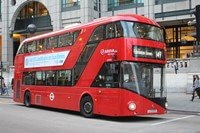
Move is aimed at keeping the Wrightbus production line open, avoiding added cost to any subsequent orders TfL makes
Transport for London’s (TfL) finance and policy committee is to ask the TfL board to approve additional unbudgeted financial, project and procurement authority for the purchase of 30 additional New Routemasters for passenger service by September 2016, taking the New Routemaster fleet size to 835. This is an increase to the current project scope.
Authority is also sought for iBus and ticketing equipment, and normal mid-life refurbishment and related matters necessary for the operation of these 30 buses.
The purchase of 30 New Routemasters will move London a step closer towards an aspiration outlined in the Mayor’s 2020 vision, which looks to raise the current proposed 805 vehicles to 2,000 by the end of the decade.
Wrightbus was awarded a contract to supply up to 1,000 New Routemaster vehicles on December 23, 2009. In September 2012, the board agreed to purchase 600 of the vehicles, with the final bus due to be delivered by March 2016.
On November 5, 2014, the board granted additional project and procurement authorities to purchase an additional 200 New Routemasters, to take the cumulative total to 808 by mid-2016, although this was subsequently reduced to 805. The production of these vehicles is almost complete and Wrightbus is due to start closing down the production lines.
The proposal is to agree an order for an additional 30 New Routemasters to take the cumulative total to 835 vehicles.
The rationale for the proposal is that placing an order now will enable Wrightbus to maintain the operation of one of its two current production lines, which keeps open a more cost effective option for purchasing additional vehicles, if TfL chooses to do so.
If both production lines were to close, it would increase the cost of any subsequent order due to the need to remobilise production.
Wrightbus has confirmed that it has the capacity to deliver the 30 additional vehicles by September 2016.
The 30 additional buses would include adjustments made to the original design, including upper and lower deck opening windows to improve ventilation and alterations to the rear door (modifications to the mechanism, voice warning and markings to improve safety). Buses would also include Microvast batteries, which are stated to have improved operational performance over the original batteries.
While no final decision has yet been taken on which additional route will be converted to New Routemaster, three potential routes have been identified. Introduction of vehicles will be through negotiation with the current operator. The vehicles will be one person operated.
Any further expansion of the fleet beyond this additional 30 will be subject to approval of the board, and will include a refresh of the business case.


